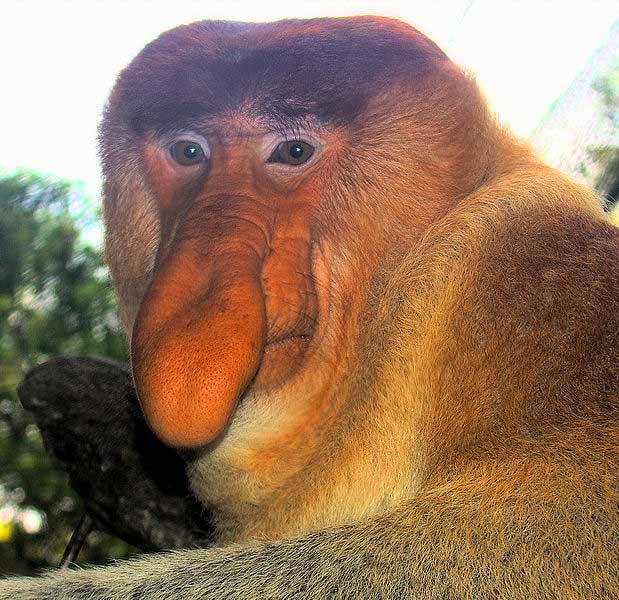Nasalis larvatus (*) Cladus: Eukaryota Name Nasalis larvatus, Wurmb, 1787 References * Nasalis larvatus on Mammal Species of the World.
-------------- The Proboscis Monkey (Nasalis larvatus) is also known as the Monyet Belanda in Malay, the Bekantan in Indonesian or simply the Long-nosed Monkey. It is a reddish-brown arboreal Old World monkey that is endemic to the south-east Asian island of Borneo. It belongs in the monotypic genus Nasalis, although the Pig-tailed Langur has traditionally also been included in this genus - a treatment still preferred by some.[3] While the official Indonesian name for this monkey is Bekantan, an Indonesian nickname is 'monyet belanda', meaning 'Dutch monkey' or 'Orang Belanda', the Indonesian word for 'Dutchman', as Indonesians noticed the Dutch colonisers often also had a large belly and nose. A distinctive trait of this monkey is the male's large protruding nose, from which it takes its name. The big nose is thought to be used to attract females and is a characteristic of the males, reaching up to 7 inches in length. The females also have big noses compared to other monkey species, but not as big as the males. Besides attracting mates, the nose serves as a resonating chamber, amplifying their warning calls. When the animal becomes agitated its nose swells with blood, making warning calls louder and more intense.[4] Ecology and habitat The Proboscis Monkey is endemic to Borneo's low elevation mangrove forests, swamps, and lowland riparian forests.[6] One of the largest populations is found in the Danau Sentarum National Park[7]. It lives in small groups of 10 to 32 animals. Group membership is very flexible, and animals are known to move from group to group quite often. The Proboscis Monkey's lifestyle is both arboreal and amphibious, with its mangrove swamp and riverine environment containing forest, dry land, shallow water allowing wading, and deep water requiring swimming. Like other similar monkeys, the Proboscis Monkey climbs well. It is also a proficient swimmer, often swimming from island to island, and has been picked up by fishing boats in open ocean a mile from shore. While wading, the monkey uses an upright posture, with the females carrying infants on their hip. Troops have been filmed continuing to walk upright, in single file, along forest trails when they emerge on land, the only non-human mammal, with the exception of gibbons and giant pangolins, known to use this form of locomotion for any length of time. Proboscis Monkeys usually lives in a harem which comprises one adult male, several females, and their offspring, but sometimes the male and female Proboscis Monkeys move between social group. The Proboscis Monkey is mostly arboreal, but sometimes the animals migrate downriver into the mangrove forest to feed.[5] The monkey also has a large belly, a result of its diet. Its digestive system is divided into compartments, with bacteria that digest cellulose and neutralize toxins from certain leaves. This lets the monkey eat leaves and remain in the forest canopy. The contents of their stomach weigh in at about a quarter of their whole body.[8] A side-effect of this unique digestive system is that it is unable to digest ripe fruit, unlike most other simians. The diet consists mainly of seeds, leaves, mangrove shoots and unripe fruit.[9] Status Due to ongoing habitat loss and hunting in some areas, only about 1000 are known to still exist in the wild. In Sarawak, the population of this species has declined from 6500 in 1977 to only 1000 in 2006. The Proboscis Monkey is evaluated as Endangered on the IUCN Red List of Threatened Species. It is listed on Appendix I of CITES.[2] The Proboscis Monkey is protected by law in all regions of Borneo. In Malaysia, this species are protected by a number of laws including: Wildlife Protection Act (Federal Law), Wildlife Protection Ordinance 1998 (Chapter 26) and Wildlife Conservation Enactment 1997 (Sabah State Law). References 1. ^ Groves, C. (2005). Wilson, D. E., & Reeder, D. M. ed. Mammal Species of the World (3rd ed.). Baltimore: Johns Hopkins University Press. pp. 168-169. ISBN 0-801-88221-4. http://www.bucknell.edu/msw3/browse.asp?id=12100619. Source: Wikispecies, Wikipedia: All text is available under the terms of the GNU Free Documentation License |
|


